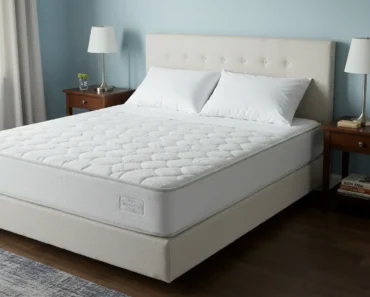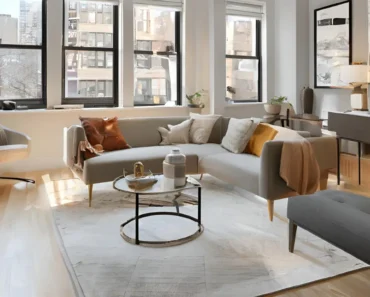Working from home has become increasingly common, and with it, the demand for functional and aesthetically pleasing small home offices. Finding the right balance between productivity and style in a limited space can be challenging. This article provides 23 practical and inspiring small home office decor ideas to help you create a workspace that boosts both your efficiency and your mood.
Maximizing Space and Light: Foundation for a Small Home Office
1. Strategic Furniture Selection: The Art of Multi-Functionality
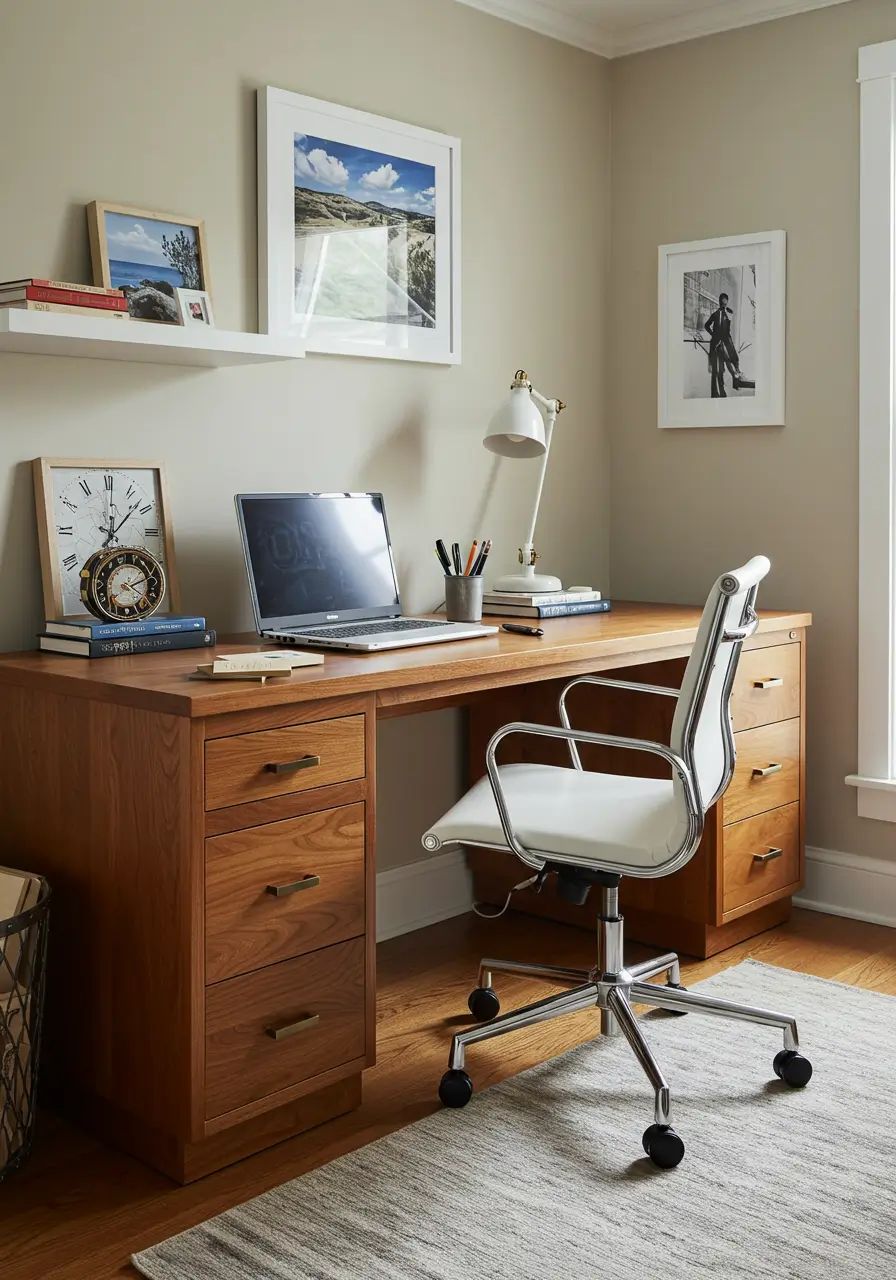
Choosing the right furniture is paramount in a small home office. The goal is to maximize functionality while minimizing footprint. Bulky, traditional desks often dominate the space. Instead, consider these alternatives:
-
Wall-Mounted Desks: These fold-down or slide-out desks are space-saving marvels. When not in use, they retract, leaving your room open and uncluttered. They’re perfect for those who need a dedicated workspace but don’t want a permanent desk taking up valuable square footage. Many are available in various styles and materials to match your décor.
-
Narrow Console Tables: A narrow console table can serve as a surprisingly functional desk, especially if you primarily use a laptop. Their slender profile takes up minimal floor space, leaving room for movement and other furniture. Consider one with drawers for added storage.
-
Multi-Functional Ottomans: Storage ottomans offer concealed storage for files, office supplies, or even extra blankets. Choose one with a sturdy top that can double as a seating area for clients or a comfortable spot to take a break. Look for options with built-in charging ports for added convenience.
-
Lift-Top Coffee Tables: These ingenious tables transform from a coffee table to a standing desk, offering flexibility throughout your workday. Ideal for those who like to switch between sitting and standing, they provide a versatile workspace without requiring additional furniture.
-
Modular Furniture: Consider modular furniture systems that allow you to customize your workspace based on your needs. These often include shelves, drawers, and desk components that can be arranged and rearranged to optimize space and functionality.
2. Mirrors, Mirrors on the Wall: Expanding Your Visual Space
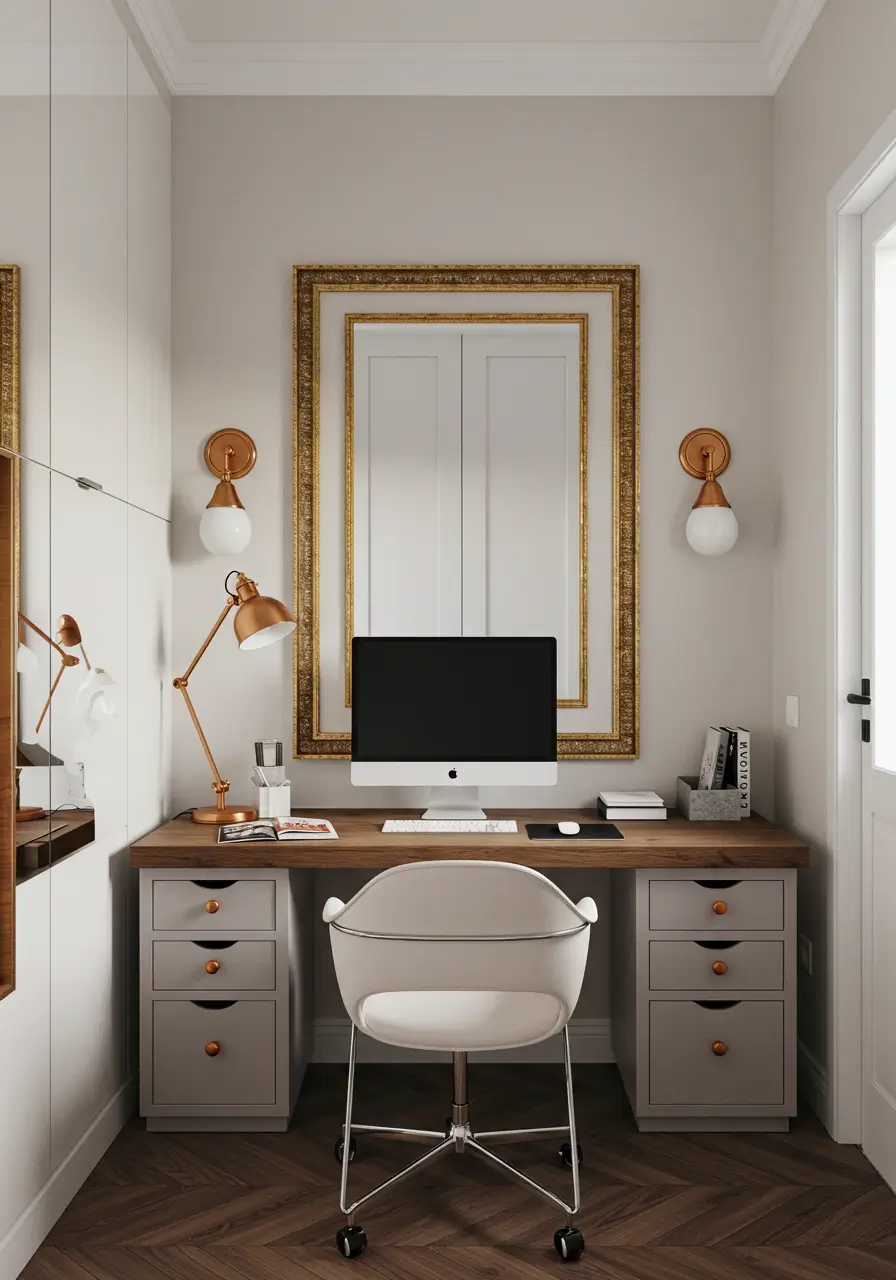
Mirrors aren’t just for bedrooms; they’re powerful tools in small home office design. Their ability to reflect light and create the illusion of depth is invaluable in a limited space.
-
Placement is Key: Don’t just slap a mirror on the wall. Strategically position it to reflect natural light from a window, thereby brightening the entire room. A large mirror opposite a window can dramatically increase the perceived size of the room.
-
Mirror Types: Consider different mirror types to complement your style. A large, framed mirror adds a touch of elegance, while a smaller, less ornate mirror can blend seamlessly into a more minimalist design. A full-length mirror might even be practical if space allows.
-
Beyond the Wall: Don’t limit yourself to wall mirrors. Consider a mirrored cabinet or a mirrored screen to add both reflective surfaces and storage.
-
Avoid Overdoing It: While mirrors are beneficial, avoid placing too many in a small space. This can create a disorienting effect, so balance is important.
3. Light and Bright Color Palette: Setting the Mood and Maximizing Light
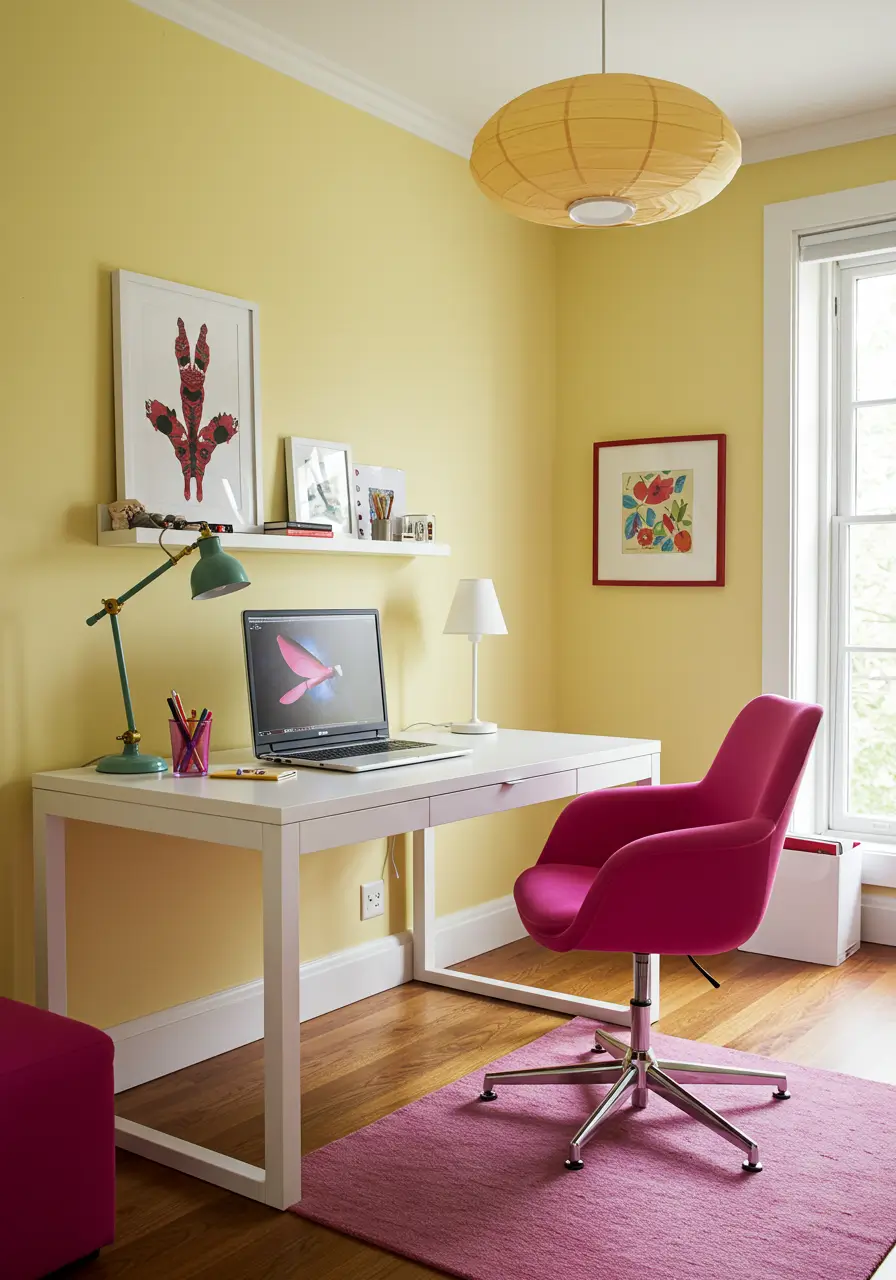
Color plays a significant role in creating the right atmosphere in your home office. Light and bright colors are your best friends in a small space.
-
Neutral Base: Start with a neutral base of white, cream, or very light gray on the walls. These colors reflect light, making the room feel larger and brighter.
-
Accents of Color: Introduce pops of color strategically using accessories, artwork, or textiles. Brighter colors can be used on smaller items like cushions, rugs, or artwork to add personality without overwhelming the space.
-
Ceiling Considerations: A light-colored ceiling reflects light downwards, making the room feel taller and more open. Avoid dark ceilings, as these can make the space feel smaller and more enclosed.
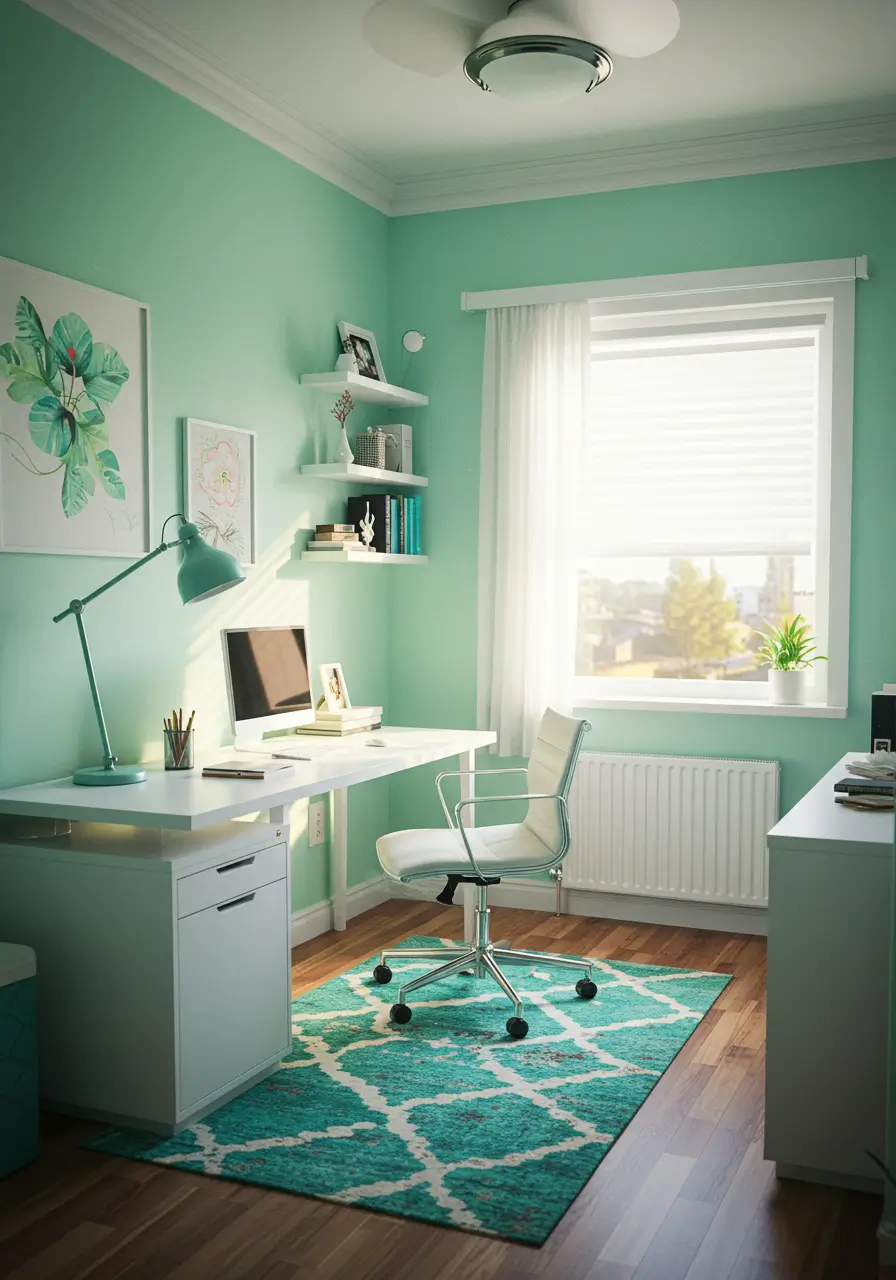
-
Consider the Light Source: The natural light in your office will influence your color choices. A room with limited natural light may benefit from warmer, lighter tones, while a sun-drenched room can handle cooler shades.
-
Psychology of Color: Remember that different colors evoke different emotions. Pale blues and greens are calming, while yellows and oranges can be energizing. Choose colors that support your work style and mood.
4. Maximize Natural Light: Harnessing the Power of the Sun
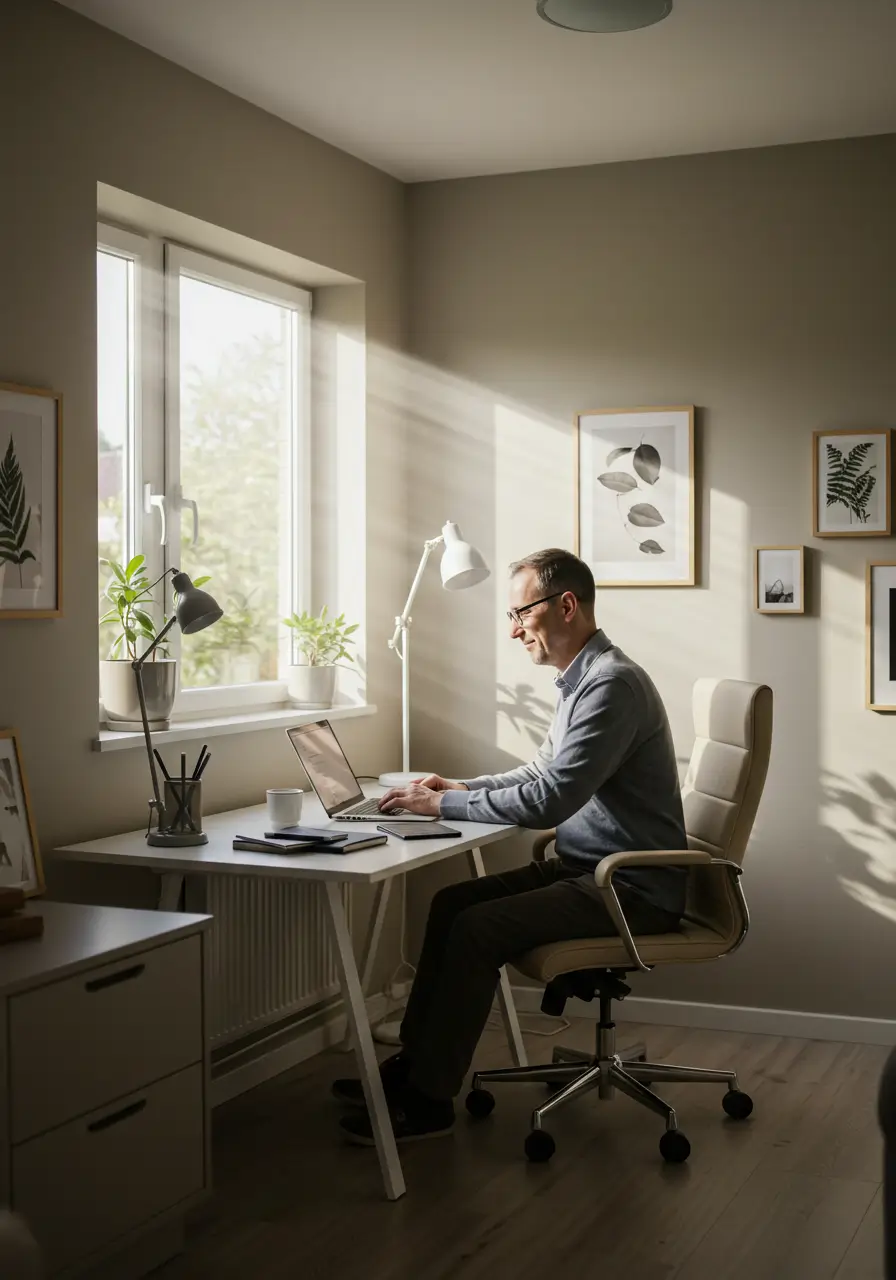
Natural light is a precious commodity in a home office. Taking advantage of it can significantly improve your workspace and overall well-being.
-
Desk Placement: Position your desk as close to a window as possible without obstructing the window’s functionality. This allows for optimal natural light during the day, reducing your reliance on artificial lighting.
-
Window Treatments: Choose window treatments that allow maximum light penetration while still providing privacy. Sheer curtains or blinds offer a balance between light and privacy. Consider cellular shades for excellent insulation and light control.
-
Reflectors: If your desk isn’t near a window, use reflective surfaces, such as mirrors or white walls, to bounce natural light deeper into the room.
-
Light-Colored Furniture: Light-colored furniture and accessories reflect light more effectively than dark ones, helping to brighten the space.
-
Maximize Window Size: If possible, increase the size of your window or improve its efficiency. Cleaning windows regularly is also important to ensure they maximize light transmission.
5. Vertical Space Utilization: Thinking Up, Not Just Out
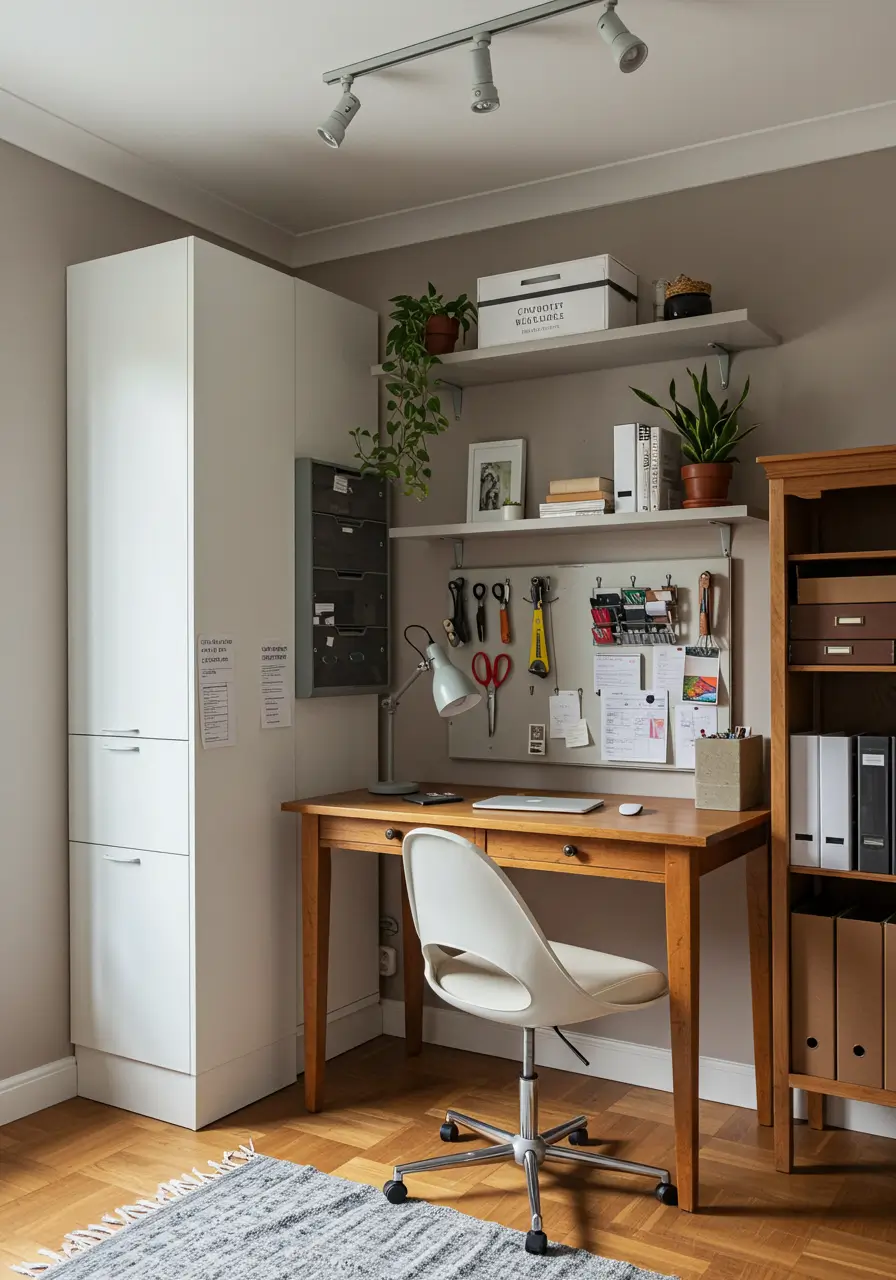
In a small home office, vertical space is often underutilized. Don’t let it go to waste!
-
Tall Bookshelves: Tall bookshelves maximize storage while adding a stylish element to the room. Choose slim bookshelves to minimize their floor footprint.
-
Wall-Mounted Organizers: These organizers provide easy access to frequently used items while keeping your desk clear. They come in various designs and materials to fit any aesthetic.
-
Floating Shelves: Floating shelves are a sleek and modern way to add storage and visual interest to your walls. They’re ideal for displaying books, plants, or decorative items.
-
Ladder Shelves: Ladder shelves offer a unique and stylish way to add vertical storage. They are visually interesting and can be used to showcase decorative items as well as store files and books.
-
Vertical File Cabinets: Rather than bulky horizontal filing cabinets, choose vertical ones to save floor space. These are particularly helpful for storing important documents and files.
Storage Solutions for a Tidy Home Office
6. Hidden Storage: The Art of Concealed Organization
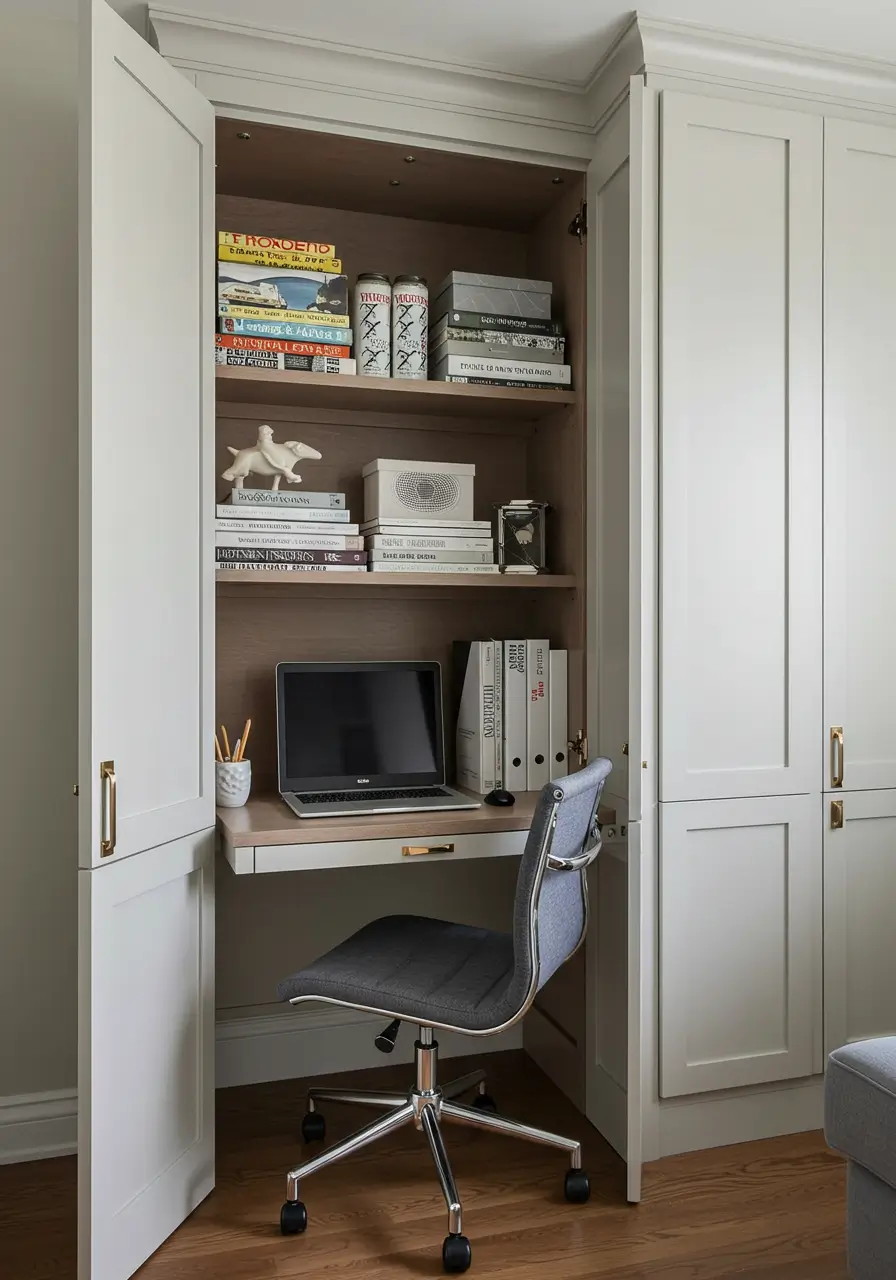
Hidden storage is your secret weapon in a small home office. It keeps clutter out of sight, maintaining a clean and uncluttered aesthetic. Here’s how to maximize hidden storage potential:
-
Storage Ottomans: These versatile pieces offer comfortable seating and ample storage space within. Choose an ottoman with a lift-top for easy access to your stored items. Consider the size and style to ensure it complements your existing décor.
-
Under-Desk Drawers and Cabinets: Look for desks with built-in drawers or consider adding rolling under-desk drawers for extra storage. These drawers can house stationery, files, and other essentials, keeping your desk surface clear.
-
Built-in Wall Cabinets: If you’re renovating or building, consider incorporating built-in wall cabinets. These offer discreet and substantial storage, seamlessly blending into your wall. Custom-designed cabinets can maximize space utilization.
-
Storage Benches: A storage bench provides seating and hidden storage for files, blankets, or other items. It’s a particularly useful option if you have limited floor space.
-
Hollow Furniture: Explore furniture with hollow compartments or hidden shelves. Some desks, sideboards, or even ottomans have cleverly concealed storage areas that are perfect for keeping less-frequently used items organized.
7. Desk Organizers: Taming the Paper Chaos
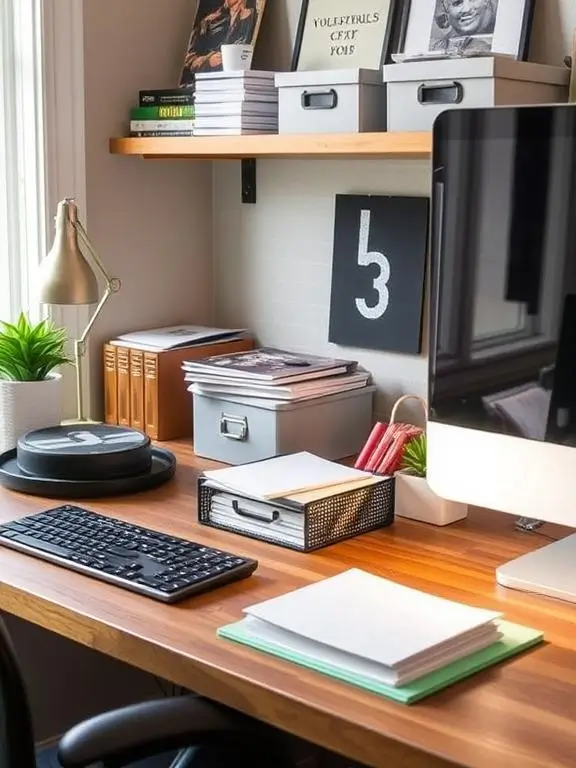
A well-organized desk is a key component of a productive workspace. Desk organizers help you keep stationery, essential tools, and other items neatly arranged.
-
Material Matters: Consider the materials when selecting your organizers. Metal organizers offer durability, while wood or bamboo options can add warmth. Plastic organizers are generally affordable and easy to clean.
-
Style and Functionality: Choose organizers that complement your home office’s style while providing the functionality you need. Look for options with multiple compartments, drawers, or trays.
-
Size and Scale: The size of your desk organizer should be proportional to the size of your desk. An overly large organizer can clutter a small desk, while a too-small one may not provide adequate storage.
-
Customization: Some organizers are customizable, allowing you to adjust the compartments to fit your specific needs. This is particularly helpful if you have a variety of items to store.
-
Vertical Space: Don’t forget to use vertical space on your desk! Vertical organizers help to maximize space efficiency and keep items easily accessible.
8. Cable Management: Conquering the Wire Jungle
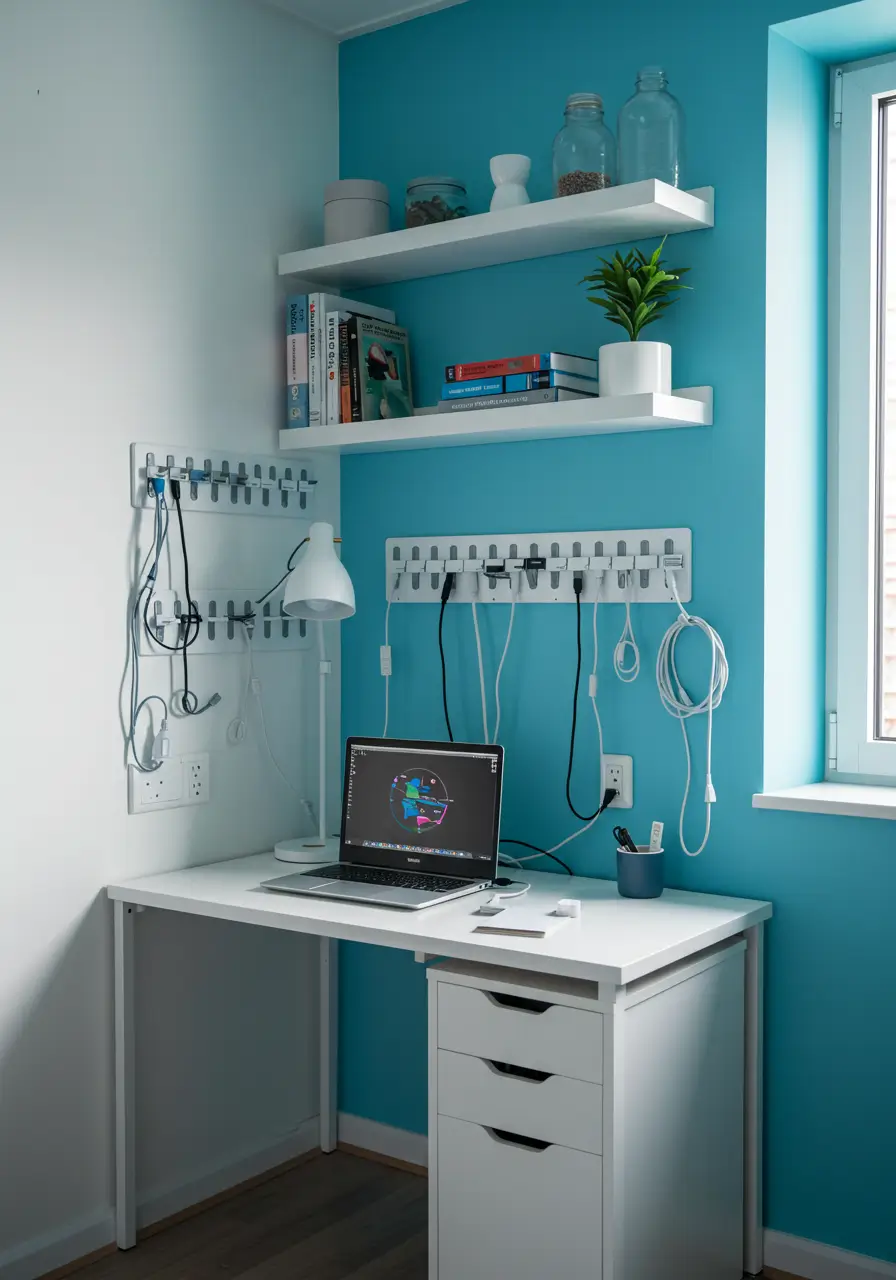
A tangle of wires can quickly derail your productivity and create a visually unappealing workspace. Effective cable management is crucial for a clean and efficient environment.
-
Cable Ties and Clips: Use cable ties and clips to bundle and secure cables, preventing them from becoming tangled. Label your cables for easy identification.
-
Cable Organizers: Cable organizers, often made of plastic or fabric, help to conceal and organize cables under your desk or along walls. These can be particularly useful for managing multiple devices.
-
Cord Covers: Cord covers are a stylish way to hide cables that run along the floor or walls. They come in various colors and styles to match your décor.
-
Power Strips and Surge Protectors: Use power strips and surge protectors to manage multiple devices and protect your equipment from power surges. Consider options with built-in cable management features.
-
Wireless Solutions: Where possible, opt for wireless peripherals like keyboards, mice, and printers to minimize cable clutter. This significantly simplifies cable management.
9. Wall-Mounted Shelves: Vertical Storage Solutions
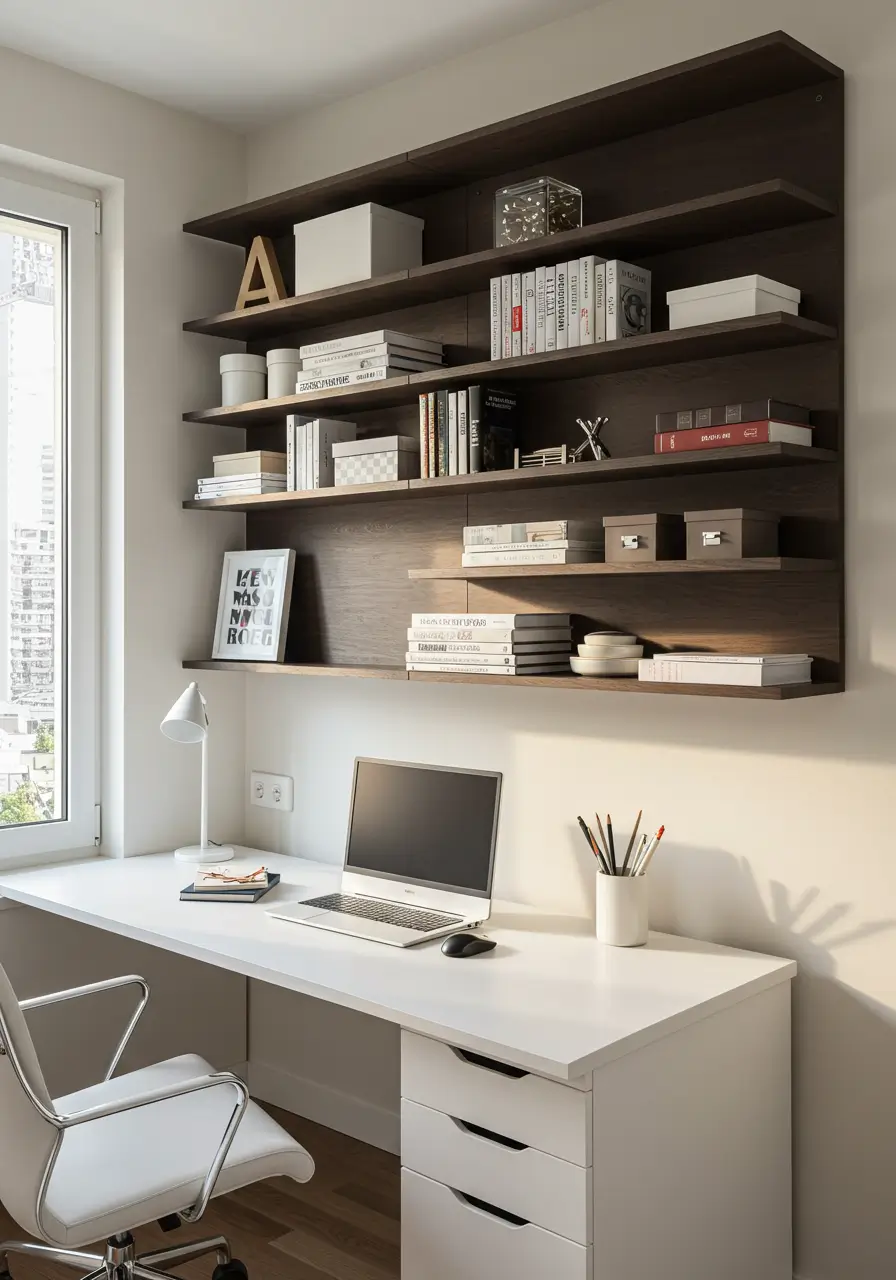
Wall-mounted shelves provide valuable storage space without occupying floor area. They’re particularly beneficial in small home offices.
-
Style and Material: Choose shelves that complement your overall office style. Wood shelves offer warmth, while metal shelves provide a more industrial aesthetic. Consider glass shelves for a more modern look.
-
Shelf Depth: Consider the depth of your shelves. Deeper shelves offer more storage but can also appear bulky on a wall.
-
Placement: Strategically place shelves to maximize their accessibility and visual appeal. Consider the placement of lighting and other elements in your office.
-
Floating Shelves: Floating shelves create a clean and modern look, seeming to float on the wall. They are a great way to add visual interest and storage.
-
Corner Shelves: Corner shelves utilize often-wasted space and add storage capacity without taking up extra wall space.
Also Read: DIY Floating Shelves for Small Home
10. File Organization System: Digital and Physical Harmony

A well-organized filing system is essential for efficient workflow, regardless of whether you prefer digital or physical files.
-
Digital Filing: Use a consistent folder structure on your computer and cloud storage. Use descriptive folder names and tags for easy searching.
-
Cloud Storage: Utilize cloud storage services for easy access to your files from anywhere. Services like Dropbox, Google Drive, and OneDrive offer secure and convenient cloud storage solutions.
-
Physical Filing: Use labeled folders and a consistent filing system for physical documents. Regularly purge outdated files to maintain order. Consider color-coded folders for visual organization.
-
File Cabinets: Choose appropriate file cabinets based on your storage needs. Vertical file cabinets are especially space-saving in small offices.
-
Scanning: Scan important physical documents and store them digitally for easy access and backup. This reduces reliance on physical storage.
Adding Personality and Style to Your Small Home Office
Your small home office should reflect your personality and inspire productivity. Don’t let it feel like just another workspace; make it a space you enjoy spending time in.
11. Personal Touches: Infusing Your Space with You
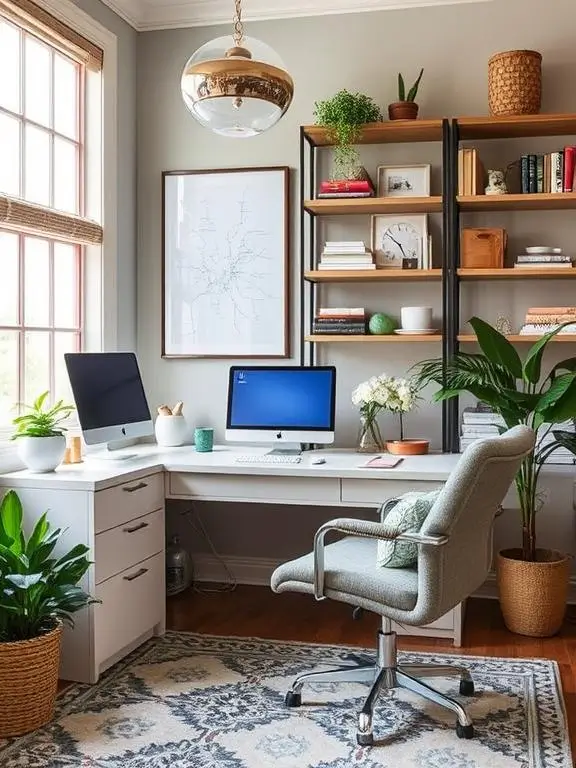
Personal touches transform a sterile workspace into a comfortable and inviting sanctuary.
-
Family Photos: Display cherished family photos in frames that complement your décor. Consider a gallery wall or a single, impactful frame.
-
Inspirational Objects: Include items that inspire you – souvenirs from travels, awards, or meaningful keepsakes. These add a personal touch and create a more engaging environment.
-
Artwork and Prints: Hang artwork that reflects your taste and inspires you. Consider prints, paintings, or even your own photography.
-
Plants and Greenery: As mentioned earlier, adding plants brings life and vibrancy to the space. Consider a variety of sizes and textures for a more layered look.
-
Textiles and Fabrics: Incorporate textiles like throws, cushions, or a small rug to add warmth and personality. Choose fabrics that complement your color scheme and overall style.
12. Inspirational Artwork: Fueling Creativity and Motivation
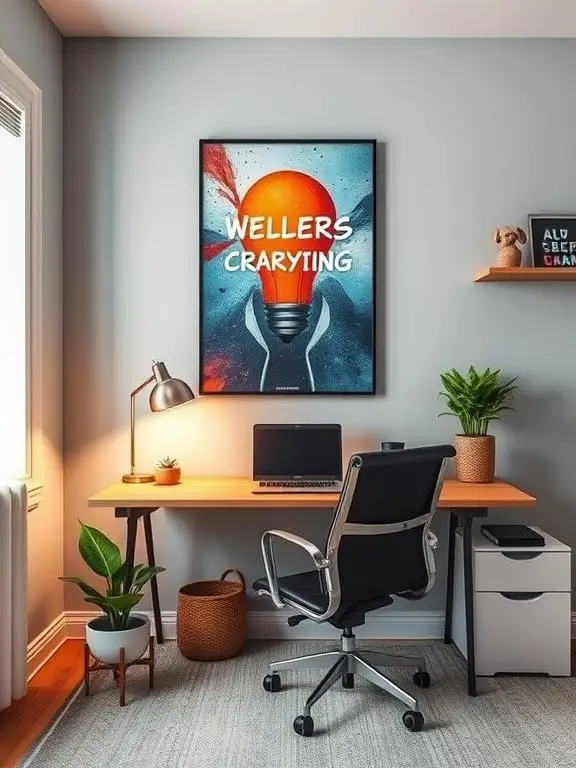
Artwork serves more than just decoration; it can significantly influence your mood and productivity.
-
Motivational Quotes: Hang a framed motivational quote or artwork that inspires you to stay focused and productive.
-
Nature Scenes: Calming nature scenes can reduce stress and promote focus. Consider landscapes, botanical prints, or abstract pieces inspired by nature.
-
Abstract Art: Abstract art can stimulate creativity and add a touch of visual interest without being overly distracting.
-
Personal Creations: Display your own artwork or crafts to add a unique and personal touch.
-
Gallery Wall: A gallery wall allows you to display multiple pieces of artwork, creating a dynamic and visually engaging focal point.
13. Plants for a Greener Workspace: Bringing the Outdoors In
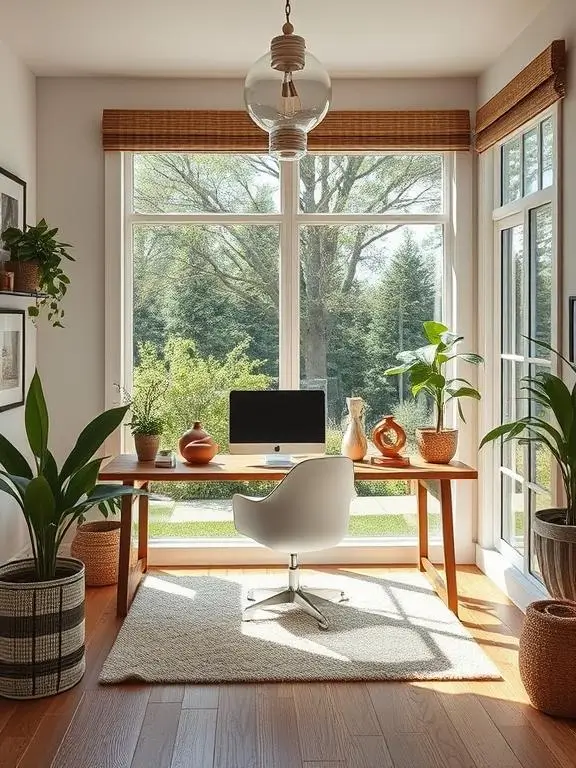
Indoor plants offer more than just aesthetic appeal; they purify the air and improve overall well-being.
-
Low-Maintenance Options: Choose low-maintenance plants like snake plants, ZZ plants, spider plants, or pothos. These are tolerant of low light and infrequent watering.
-
Variety of Sizes and Textures: Mix and match different sizes and textures of plants for a more layered and interesting look.
-
Placement: Place plants strategically to maximize their visual impact without obstructing workflow.
-
Plant Stands: Use plant stands to elevate your plants and create visual interest.
-
Artificial Plants: If you lack time for plant care, consider high-quality artificial plants. They offer a similar aesthetic appeal without the maintenance.
14. Comfortable Seating: Ergonomics and Style
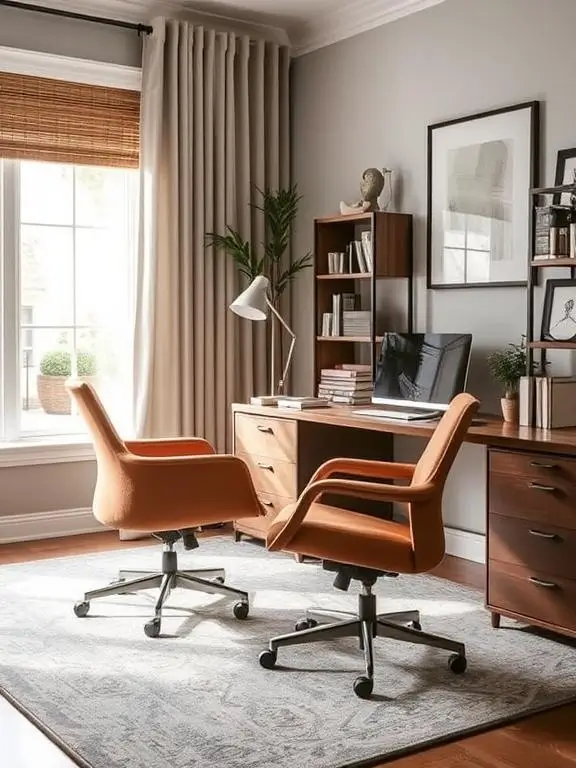
Your chair is arguably the most important piece of furniture in your home office. It directly impacts your posture and comfort.
-
Ergonomic Considerations: Prioritize ergonomics when choosing a chair. Look for features like adjustable height, lumbar support, and armrests.
-
Style and Aesthetics: Choose a chair that complements your office’s style while ensuring optimal comfort and support.
-
Material Selection: Consider the material of the chair – mesh, leather, or fabric – based on your climate and personal preference.
-
Chair Mat: A chair mat protects your floor from damage and makes rolling your chair smoother and quieter.
-
Footrest: If your chair doesn’t provide adequate foot support, consider a footrest to improve posture and comfort.
15. Area Rug Definition: Adding Warmth and Texture

An area rug defines your workspace and adds warmth and texture to the floor.
-
Size and Placement: Choose a rug that’s large enough to accommodate your desk and chair, creating a defined workspace.
-
Material and Texture: Consider different materials, such as wool, cotton, or synthetic fibers, to achieve the desired texture and style.
-
Color and Pattern: Select a rug that complements your color scheme and overall office style.
-
Maintenance: Choose a rug that’s easy to clean and maintain.
-
Layering: Consider layering a smaller rug on top of a larger one to create visual interest and depth.
Technology Integration and Ergonomics
Technology is an essential part of most home offices. Integrating it ergonomically is key to productivity and well-being.
16. Ergonomic Setup: Prioritizing Comfort and Health
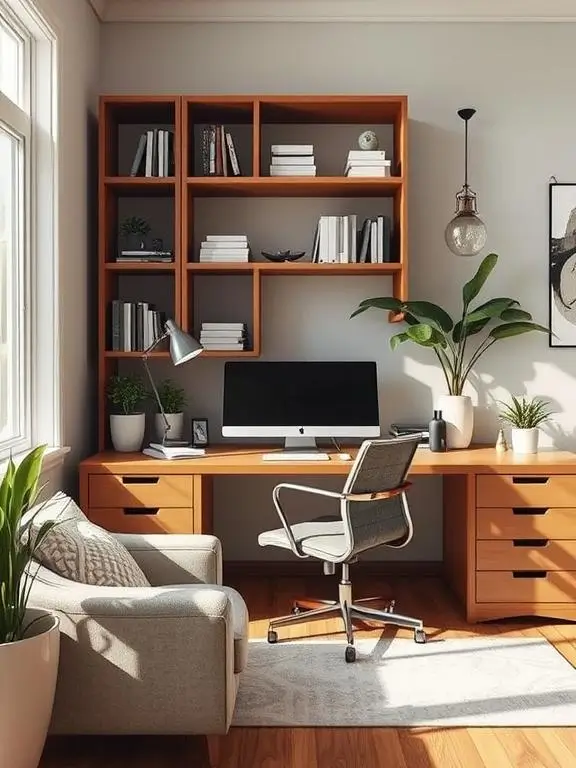
An ergonomic setup minimizes strain and maximizes comfort, promoting better posture and preventing long-term health issues.
-
Chair Height: Adjust your chair height so your feet are flat on the floor and your thighs are parallel to the floor.
-
Monitor Placement: Position your monitor at arm’s length, with the top of the screen at or slightly below eye level.
-
Keyboard and Mouse Placement: Keep your keyboard and mouse close to your body, avoiding excessive reaching or twisting.
-
Lighting: Ensure adequate lighting to prevent eye strain.
-
Breaks and Movement: Take regular breaks to stretch and move around to avoid stiffness and fatigue.
17. Monitor Placement: Protecting Your Eyes and Neck

Improper monitor placement can lead to eye strain, headaches, and neck pain.
-
Eye Level: The top of your monitor should be at or slightly below eye level.
-
Distance: Position your monitor at arm’s length to avoid straining your eyes.
-
Monitor Stand: Use a monitor stand to adjust the height and angle of your monitor.
-
Multiple Monitors: If using multiple monitors, arrange them in a way that minimizes neck strain.
-
Screen Brightness: Adjust your screen brightness to match the ambient lighting in your room.
18. Keyboard and Mouse Placement: Minimizing Strain
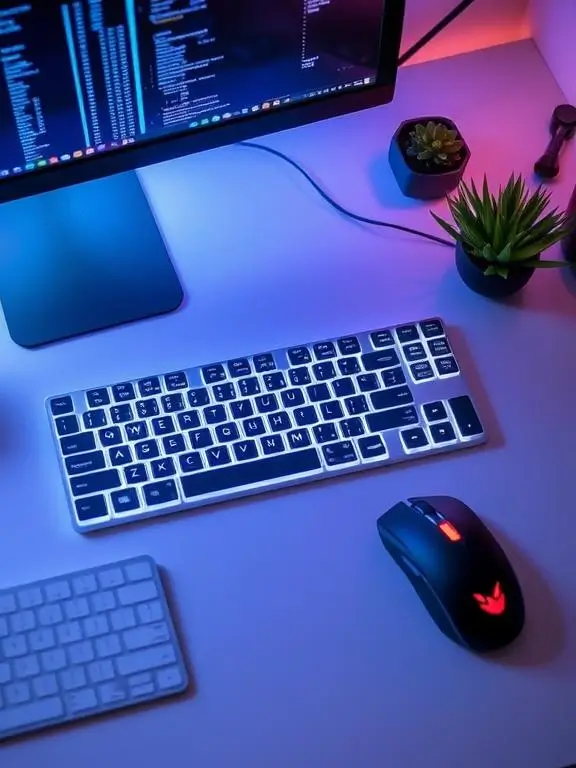
Proper keyboard and mouse placement minimizes strain on your wrists, hands, and arms.
-
Neutral Posture: Keep your wrists straight and avoid bending or flexing them excessively.
-
Ergonomic Keyboard: Consider an ergonomic keyboard to promote a more natural hand position.
-
Ergonomic Mouse: Use an ergonomic mouse to reduce strain on your wrist and hand.
-
Wrist Rests: Use wrist rests to support your wrists while typing.
-
Adjustability: Ensure that your keyboard and mouse are easily accessible and positioned for comfort.
19. Adequate Lighting: Illuminating Your Workspace
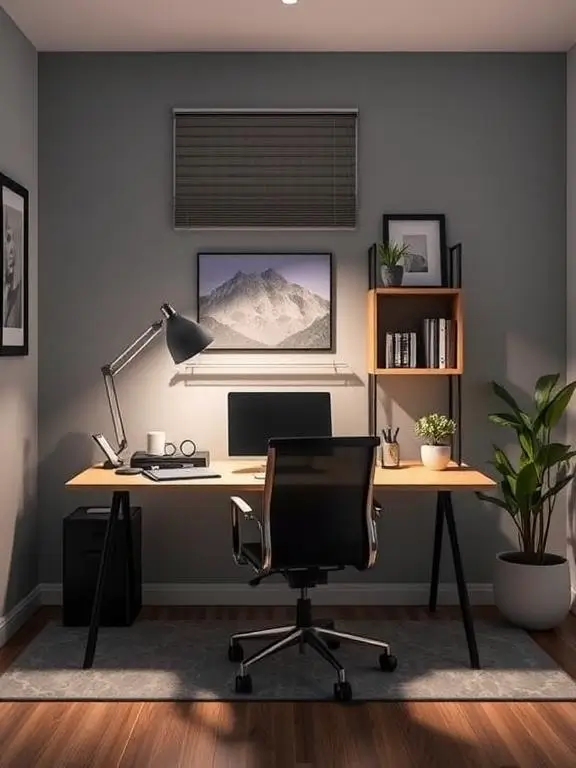
Proper lighting is crucial for reducing eye strain and creating a productive workspace.
-
Natural Light: Maximize natural light whenever possible.
-
Ambient Lighting: Use ambient lighting to provide overall illumination.
-
Task Lighting: Use a desk lamp or other task lighting to focus light on your work area.
-
Accent Lighting: Use accent lighting to highlight specific areas or features in your office.
-
Color Temperature: Consider the color temperature of your lighting. Cooler light is generally better for daytime work, while warmer light can be more relaxing in the evening.
Also Read: The 60–30–10 Rule: Mastering Interior Design with Ease
20. Power Outlets: Managing Your Devices Efficiently
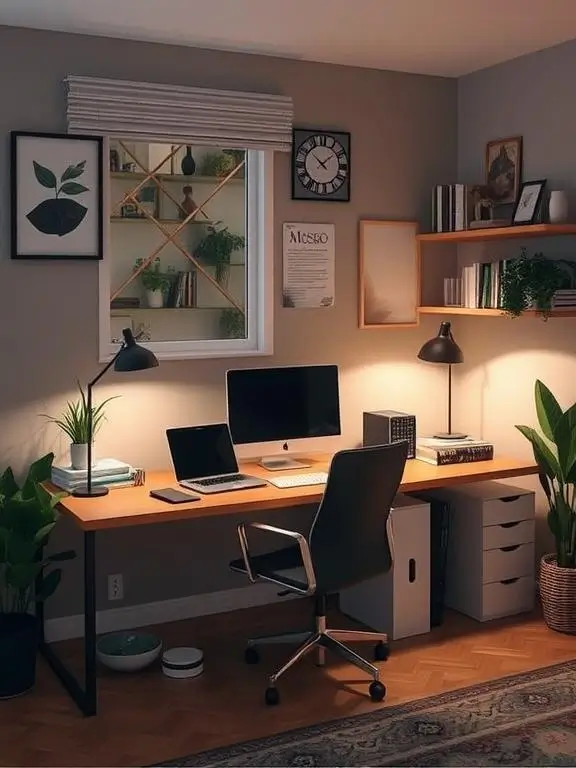
Adequate power outlets are essential for managing multiple devices.
-
Power Strip: Use a power strip to consolidate multiple devices into a single outlet.
-
Surge Protector: Use a surge protector to protect your devices from power surges.
-
Placement: Position power strips and surge protectors strategically for easy access.
-
Cable Management: Use cable ties or organizers to keep your wires neat and tidy.
-
Wireless Solutions: Consider wireless devices to minimize the number of cables.
Finishing Touches for a Polished Look
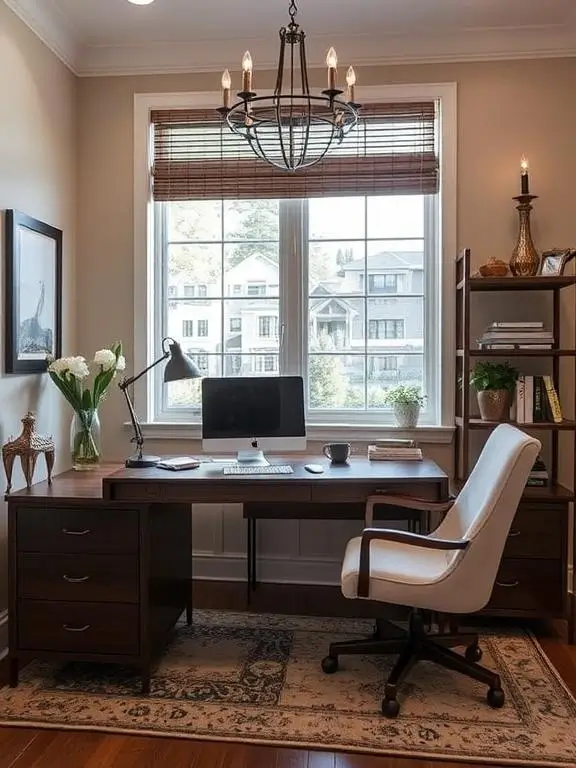
The finishing touches elevate your small home office from functional to stylish and inviting.
21. Statement Piece: Adding Visual Interest and Personality
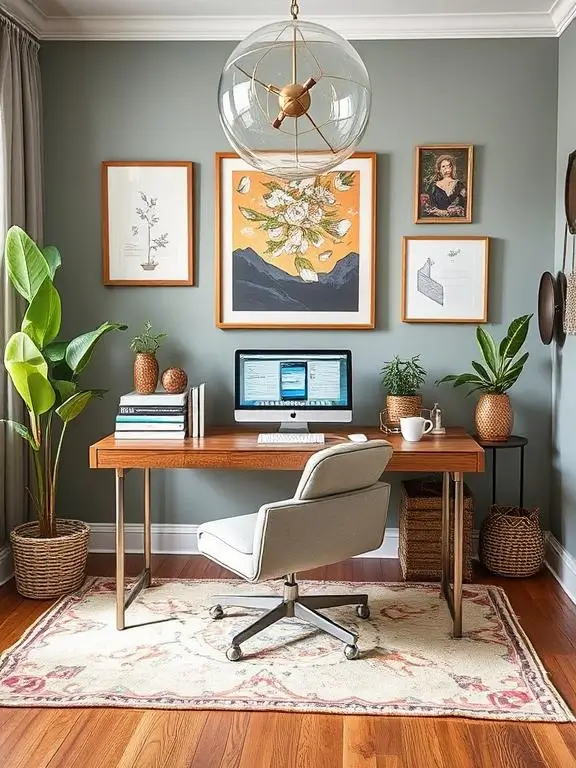
A statement piece adds personality and visual interest to your home office.
-
Unique Lamp: A stylish lamp adds both function and visual appeal.
-
Eye-Catching Artwork: A large piece of art can serve as a focal point for the room.
-
Stylish Bookshelf: A well-designed bookshelf showcases your books and adds to the overall aesthetic.
-
Decorative Objects: Incorporate decorative objects that reflect your personal style.
-
Plant Feature: A large statement plant adds life and vibrancy to the room.
22. Texture and Pattern: Creating Visual Depth and Interest
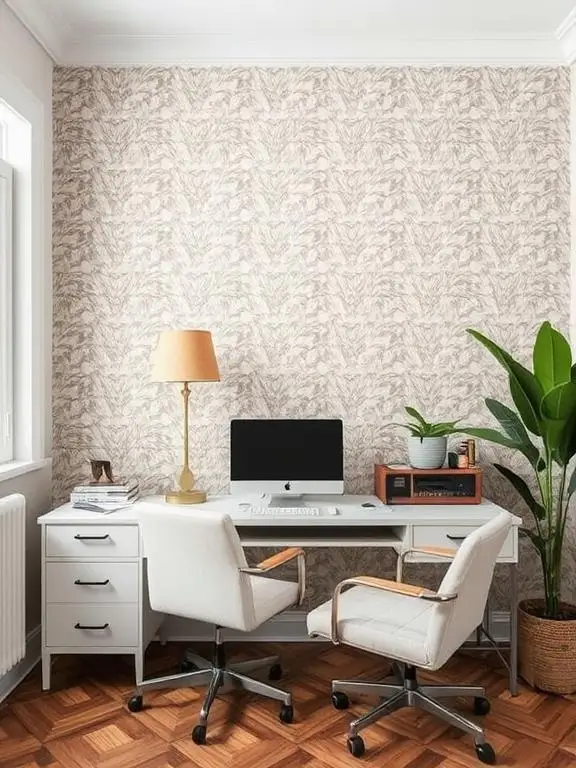
Introducing texture and pattern adds visual depth and interest to your small home office.
-
Rugs: Different textures in rugs add warmth and depth.
-
Fabrics: Use textiles like throws and cushions to introduce texture and pattern.
-
Wall Art: Use textured wall art to add visual interest.
-
Decorative Objects: Incorporate decorative objects with varying textures.
-
Materials: Combine different materials, like wood, metal, and glass, to create visual interest.
23. Regular Decluttering: Maintaining a Productive Environment
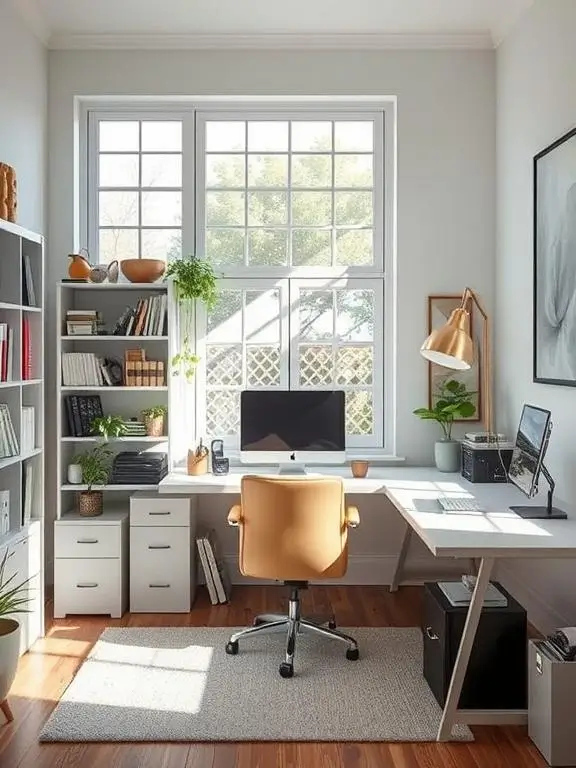
Regular decluttering is key to maintaining a clean, organized, and productive workspace.
-
Scheduled Decluttering: Set aside time each week or month for decluttering.
-
Designated Storage: Have designated storage for items you don’t use frequently.
-
Digital Decluttering: Regularly delete or archive unnecessary digital files.
-
“One In, One Out” Rule: For every new item you bring into your office, remove an old one.
-
Minimalist Approach: Adopt a minimalist approach to avoid clutter buildup.
Conclusion: Your Small Home Office, Your Sanctuary
Creating a functional and stylish small home office is achievable with careful planning and attention to detail. By implementing these 23 ideas, you can transform your small workspace into a productive and inspiring sanctuary that supports your work and enhances your well-being. Remember to prioritize your comfort, functionality, and personal style to create a space truly reflective of your needs and aesthetic preferences. A well-designed small home office can significantly improve your work-life balance and overall productivity.
Frequently Asked Questions (FAQs)
1. How can I make my small home office feel more spacious? Use light colors, mirrors, and minimal furniture. Maximize vertical space with shelves and avoid bulky items.
2. What are the essential elements of an ergonomic home office setup? An ergonomic setup includes a comfortable and adjustable chair, a monitor at eye level, and proper keyboard and mouse placement. Good lighting is also crucial.
3. What kind of lighting is best for a small home office? A combination of ambient, task, and accent lighting is ideal. Ambient lighting provides overall illumination, task lighting focuses on your work area, and accent lighting highlights specific features.
4. How can I incorporate storage effectively in a small home office? Utilize vertical space with shelves, drawers, and cabinets. Consider hidden storage solutions like ottomans and under-desk drawers.
5. What are some low-maintenance plants suitable for a home office? Snake plants, ZZ plants, and pothos are all relatively low-maintenance options that tolerate low light conditions.
